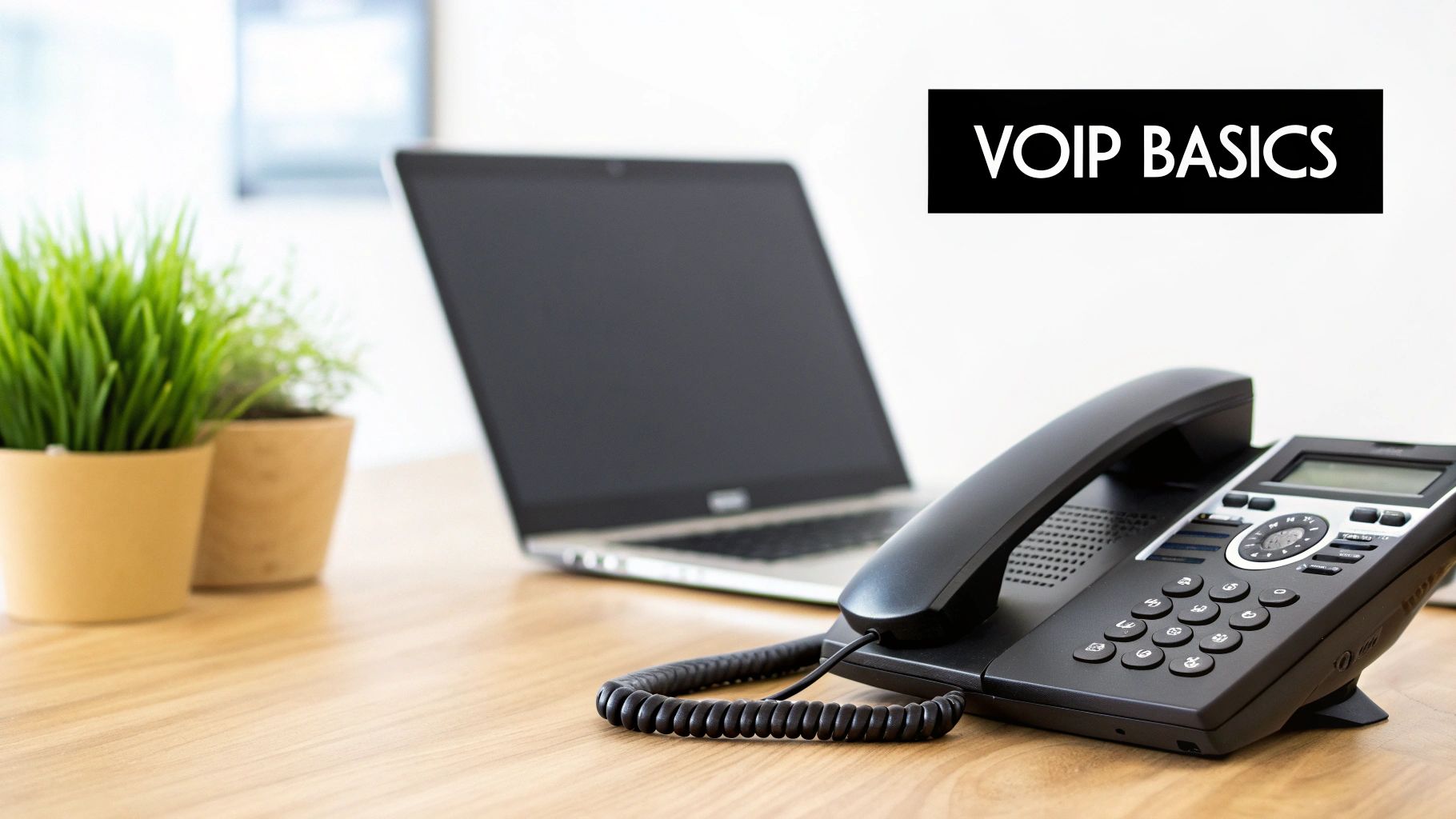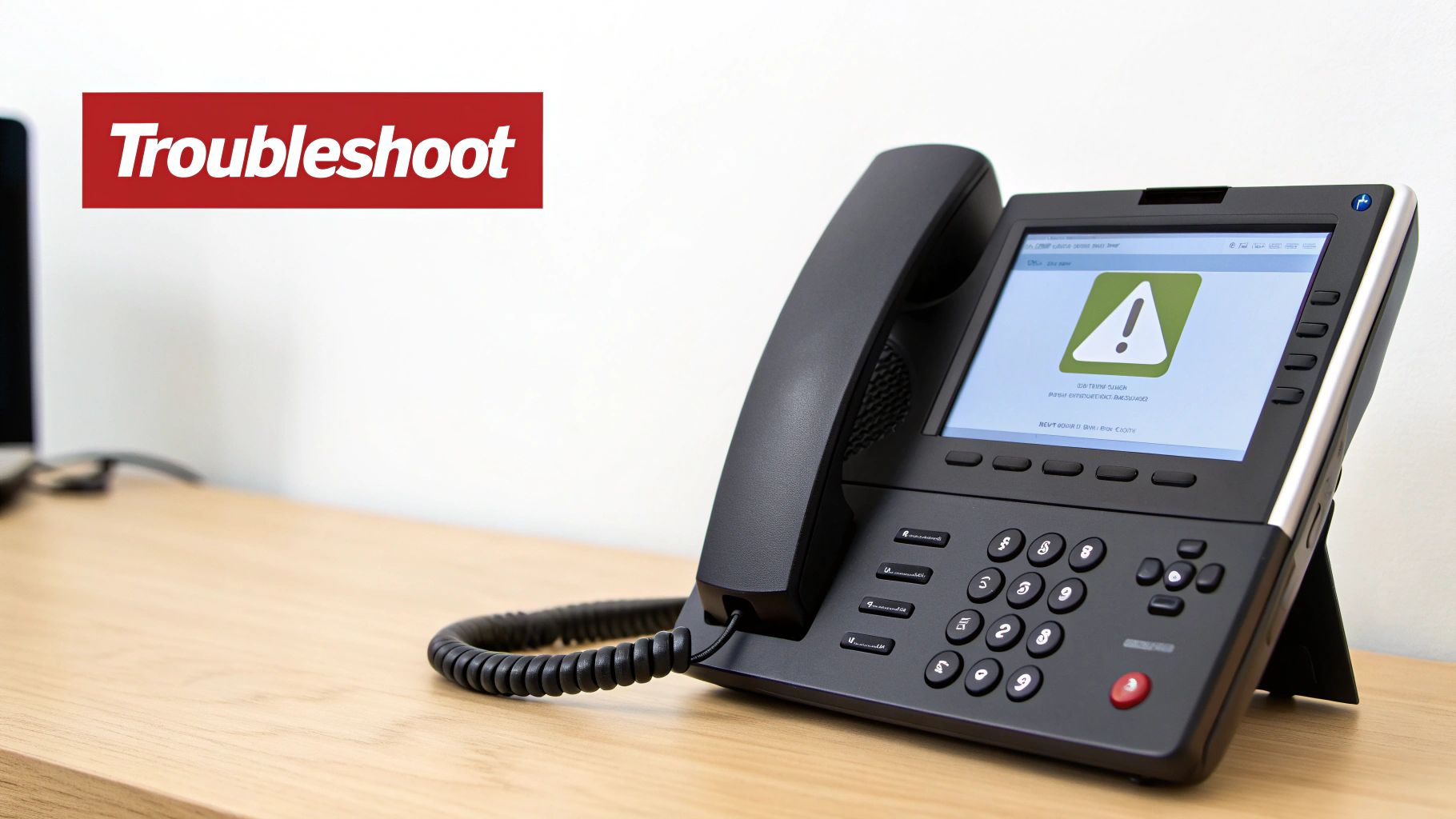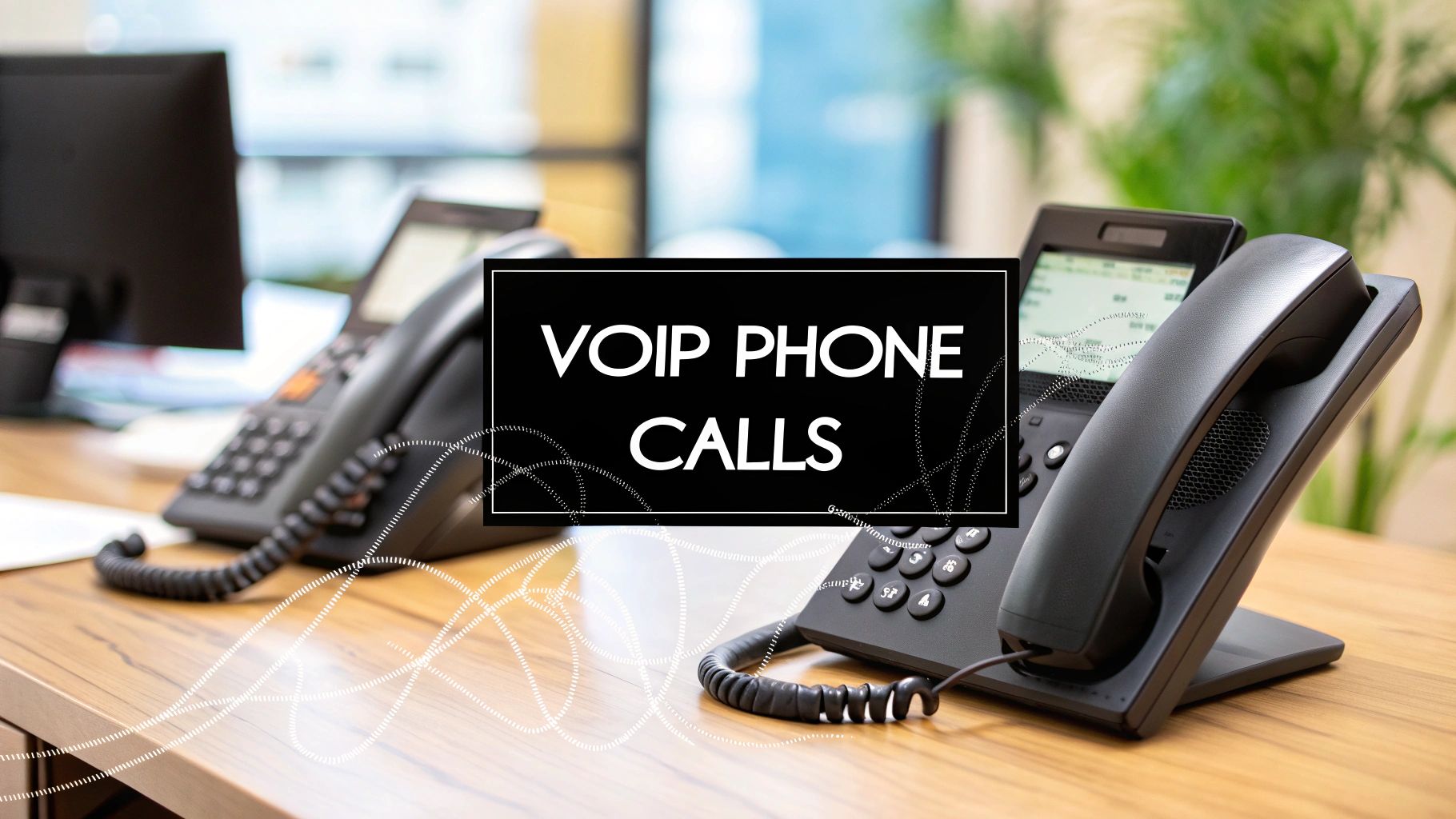If you're still running your business on traditional phone lines, you might as well be sending faxes and hoping for the best. A VoIP telephone to telephone system isn't just a minor upgrade; it's a complete reimagining of what a phone system can do. By converting your voice into digital data and sending it over the internet, it moves your communications into the 21st century, unlocking efficiency, scalability, and serious cost savings.
Moving Your Business Calls to the Internet

Making the jump to a VoIP telephone to telephone system is a fundamental change in how your business communicates. Forget the old-school copper wires and the local phone company. This technology uses the internet connection you already have to handle all your calls. Think of it this way: your voice simply becomes another piece of data, just like an email or a file you download.
This isn't just a technical swap—it's a strategic one. For years, the Public Switched Telephone Network (PSTN) kept businesses on a tight leash. Need a new phone line? That meant a costly and slow installation. Calling internationally? Get ready for a massive bill. VoIP breaks all those old rules.
The Core Advantages of Internet-Based Calling
At its heart, switching to VoIP is about gaining a level of flexibility and control that was impossible with older systems. When your calls run over the internet, you instantly tap into powerful tools you can manage from a simple dashboard, not a dusty server closet. This digital backbone is what enables the kind of agile, responsive communication that modern business demands.
So, what’s really pushing companies to make the switch? It boils down to a few game-changing benefits:
- Serious Cost Savings: You can say goodbye to expensive line rentals, high maintenance fees, and eye-watering per-minute charges, especially on international calls.
- Effortless Scalability: Need to add 10 new lines for a seasonal rush? It’s a few clicks in a software portal, not a weeks-long hardware project. You can scale up or down as your business needs change.
- Work From Anywhere: Your business phone number is no longer chained to a desk. An employee can answer their office line from a laptop at home, a mobile app on the road, or a headset in a coworking space.
- Features Galore: Advanced tools that used to cost a fortune—like auto-attendants, call recording, in-depth analytics, and CRM integrations—are often built right in.
The real win with VoIP is how it weaves communication directly into your business operations. It’s not just a phone system replacement; it’s a platform for building smarter, more connected relationships with your customers.
Ultimately, swapping out analog lines for a VoIP telephone to telephone setup is about preparing your company for the future. It creates the foundation for a unified communications system where voice, email, chat, and video all work together seamlessly. In this guide, we’ll pull back the curtain and show you exactly how this technology works, giving you the insights to build a reliable and secure system for your own business.
How a VoIP Call Travels from Phone to Phone
When you make a VoIP telephone to telephone call, you’re not just dialing a number—you're launching a high-speed digital journey. It all begins the second you press "call." Instead of a simple electrical signal zipping down a copper wire, your VoIP phone acts like a tiny, dedicated computer, immediately converting your voice into digital data.
This initial step is called digitization, where the analog waves of your voice are translated into a stream of ones and zeros. But just sending that raw data across the internet isn't very efficient. That's where codecs (an abbreviation of coder-decoder) come into the picture. A codec is a smart algorithm that compresses your voice data into small, easy-to-manage units called packets.
You can think of a codec as an expert packer getting a fragile item ready for shipment. It skillfully removes any redundant information without sacrificing the essential quality of your voice, making the data packets much smaller and faster to send. This compression is crucial for preventing frustrating delays and keeping your internet bandwidth free.
The Digital Highway and Its Traffic Controller: SIP
Once your voice is neatly packaged, it needs a clear set of directions to find its destination. This is the job of the Session Initiation Protocol (SIP). SIP is essentially the traffic controller for the VoIP world; it’s the signaling protocol that handles setting up, managing, and eventually ending the call.
When you dial a number, your VoIP phone sends a SIP "invite" message out across the internet. This message is packed with all the necessary details, like the recipient’s address and the types of codecs your phone can use. The invitation travels to your VoIP provider's servers, which act as a digital switchboard to locate the person you're calling and forge the connection.
After the call connects, SIP takes a slight step back. The actual voice packets—your conversation—start flowing directly between you and the other person using a different protocol, usually the Real-time Transport Protocol (RTP). All the while, SIP keeps an eye on the call's status. When you finally hang up, it sends one last "bye" message to terminate the session cleanly.
The entire SIP handshake, from the moment you dial to hearing that first "hello," often happens in less than a second. It's a complex digital negotiation that feels completely instantaneous to you.
Bridging the Gap Between VoIP and Traditional Phones
So, what happens when your VoIP telephone to telephone call is headed for an old-school landline or a mobile phone? Those devices are part of the Public Switched Telephone Network (PSTN), which speaks an entirely different, analog language. For the two systems to communicate, the call needs a translator.
This critical translation job is handled by a PSTN gateway. The gateway is the bridge that connects the modern, internet-based VoIP network to the traditional, circuit-switched telephone network.
This diagram shows the journey in a simplified format.

As the visual shows, the core path involves a digital signal becoming internet data packets, which can then be converted back into a traditional audio signal if the call needs to cross over to the PSTN.
When your voice packets reach the gateway, a few things happen in a split second:
- De-packetization: The gateway takes the individual packets and reassembles them into a single, coherent stream of digital data.
- Decoding: The codec's compression is reversed, turning that digital data back into an analog audio signal.
- Transmission: This newly minted analog signal is then sent out across the traditional PSTN to make the recipient's landline or mobile phone ring.
This whole process happens in reverse for the person on the other end, as the gateway converts their analog voice into digital packets to send back to you. This seamless, two-way translation happens in real-time, allowing for a smooth conversation between two completely different phone networks. It’s this sophisticated, behind-the-scenes technology that makes modern business communication so incredibly versatile.
The Building Blocks of a Reliable VoIP System

A dependable voip telephone to telephone system isn't a single piece of technology. It’s an ecosystem of several core components working in perfect concert. To really get a feel for how it delivers such clear, reliable calls, you have to understand the specific role each part plays. These aren’t just technical terms; they’re the engine parts that give your business communication its power and flexibility.
Think of it like building a modern skyscraper. You need a solid foundation, a strong structural frame, and an intelligent control system to manage everything. In the world of VoIP, these roles are filled by SIP Trunks, VoIP gateways, and the IP PBX.
Each piece of the puzzle solves a unique challenge, from connecting your internal system to the outside world to intelligently managing your internal call traffic. Let's break down how they interact, which is the first step toward building a system that truly supports your business goals.
SIP Trunks: The Digital Superhighways
It's time to forget about the old-school physical phone lines that could only handle one call at a time. SIP Trunks are the modern, virtual replacement. The best way to picture them is as multi-lane digital superhighways connecting your office phone system to the public telephone network, all running over your existing internet connection.
A traditional phone line is a rigid, physical wire. A SIP Trunk, on the other hand, is a software-based link that can carry numerous calls at once. This design provides incredible scalability. If your business is growing or you hit a seasonal spike in call volume, you can add more "lanes" to your highway almost instantly. No more waiting for a technician to come out and install new copper wiring.
SIP Trunks effectively decouple your phone capacity from physical infrastructure. Your ability to handle calls is no longer limited by how many wires are in the wall but by your internet bandwidth and subscription plan.
This virtualization is what drives such significant cost savings. Many businesses find they slash their monthly telecom expenses by up to 60% when they switch from traditional line rentals to SIP trunking.
To see the difference clearly, let's compare the old with the new.
Traditional PSTN Lines vs Modern SIP Trunks
This table breaks down the key differences between traditional phone lines and SIP Trunks, highlighting why so many businesses are making the switch.
| Feature | Traditional PSTN Lines | SIP Trunks |
|---|---|---|
| Connection Type | Physical copper wires | Virtual channels over the internet |
| Scalability | Rigid; requires new physical line installation | Highly flexible; add or remove channels on demand |
| Cost Structure | Per-line monthly rental, plus call charges | Per-channel monthly fee, often with bundled minutes |
| Geographic Flexibility | Tied to a physical location | Not tied to a location; can use numbers from any area code |
| Capacity | One call per line | Multiple simultaneous calls per trunk |
| Setup Time | Days or weeks for new lines | Minutes or hours for new channels |
The takeaway is clear: SIP Trunks offer a more agile, cost-effective, and powerful way for businesses to connect to the global phone network.
VoIP Gateways: The Universal Translators
Even if your business is all-in on VoIP, many of your customers, partners, and suppliers are still using traditional landlines and mobile phones. This is where the VoIP gateway comes in. It’s the essential bridge that connects these two different worlds, acting as a real-time translator between them.
A gateway’s job is to convert the digital data packets from a VoIP call into the analog signals the old phone network understands, and vice-versa. This ensures that a call from a voip telephone to telephone system connects perfectly to a standard cell phone without any hiccups or drops in quality. It’s the behind-the-scenes hero that guarantees your calls can reach anyone, anywhere.
You’ll typically encounter two types of gateways:
- Analog Gateways: These are perfect for connecting older analog phones or fax machines to a modern IP phone system, letting you get more life out of your legacy equipment.
- Digital Gateways: These are more common in larger organizations, used to connect an on-premise IP PBX to digital PSTN lines (like an ISDN PRI) during a phased migration to full VoIP.
The IP PBX: The Brain of the Operation
At the very heart of your VoIP system is the IP Private Branch Exchange (IP PBX). This is the command center—the brain that manages and directs every single call. It handles all the critical functions that make a business phone system so powerful, from routing incoming calls to the right person to enabling features like voicemail, call forwarding, and conference calls.
An IP PBX can be set up in two main ways, each with its own advantages:
- On-Premise IP PBX: This is a physical server or appliance that sits in your office’s server room. It gives you direct, hands-on control over the hardware and configuration.
- Hosted or Cloud IP PBX: With this model, the PBX is delivered as a service from your VoIP provider's secure data centers. This eliminates the need for on-site hardware and maintenance, offering a more subscription-based approach.
The IP PBX is also where critical security protocols are managed. Securing your conversations is a top priority, and protocols like SIP over TLS create an encrypted, secure channel for your call signaling. By understanding how these components work together, you can make an informed decision and build a VoIP setup that is a true asset to your business.
Achieving Crystal-Clear VoIP Call Quality
For any business, a phone call is a direct handshake with a customer or partner. When that connection is full of choppy audio or suddenly drops, it sends a terrible message about your organization. Making sure every voip telephone to telephone call is crystal clear isn't just a technical detail—it’s a cornerstone of your professional reputation.
This level of quality doesn't just happen. It’s the direct result of understanding and actively managing all the things that can disrupt voice data as it zips across your internet connection. Thankfully, with the right approach and a few key tools, maintaining excellent call quality is well within your control.
The biggest hurdles standing in the way of clear VoIP calls are almost always network performance issues. These aren't just abstract terms for the IT department; they are real-world problems that turn a smooth conversation into a frustrating mess.
The Enemies of a Good Conversation
When your voice becomes data, it’s broken down into tiny "packets" that need to travel from point A to point B—and they need to get there fast and in the right order. Any hiccup on this digital journey spells trouble for your audio quality. The three usual suspects are jitter, latency, and packet loss.
Think of your conversation as a long train, with each car carrying a single word of a sentence.
-
Jitter: This is what happens when the train cars arrive all mixed up. If the sentence "How can I help you today?" shows up as "Help I today can you how?", the message is lost. In a call, this sounds like robotic, garbled speech.
-
Latency: This is simply the delay it takes for the train to reach its destination. High latency creates that awkward, unnatural pause where you and the other person start talking over each other because the audio hasn't caught up yet.
-
Packet Loss: This is when some of the train cars just vanish along the way. The result is noticeable gaps in the conversation, where words or even whole phrases disappear completely, sometimes causing the call to drop entirely.
A study on user perception found that latency above 150 milliseconds significantly degrades the conversational experience. Keeping latency low is absolutely essential for natural, back-and-forth communication.
So, how do you fight back against these issues? You need to give your voice traffic a priority pass on your network's digital highway. That’s where Quality of Service comes in.
Prioritizing Your Voice Traffic with QoS
Quality of Service (QoS) is a networking feature that basically creates a dedicated express lane for your voice data. It tells your network router to always prioritize voice packets over other, less urgent traffic like sending emails or downloading large files.
With QoS properly configured, your voip telephone to telephone calls are shielded from the chaos of a busy network. Even if someone in the office decides to download a massive video file, your call quality stays perfectly clear because your voice packets are always waved to the front of the line.
Putting QoS in place is one of the single most effective things you can do to guarantee a flawless communication experience for your team and your customers.
Beyond QoS, a few other practical steps are key to maintaining top-notch VoIP call quality:
- Sufficient Bandwidth: Make sure your internet plan has enough horsepower—both upstream and downstream—to handle your peak call volume on top of all your other data needs.
- A Strong Service Level Agreement (SLA): Partner with a provider that contractually guarantees performance standards for uptime, packet loss, and jitter. This gives you a safety net if quality doesn't meet expectations.
- Wired Connections: Whenever possible, plug your VoIP phones directly into the network with an Ethernet cable. Wi-Fi is convenient, but it's far more prone to interference and signal drops that can wreck a call.
By actively managing these factors, you can build a communication system that is not only powerful but also incredibly reliable, ensuring every call is as crisp and clear as it should be.
Why Businesses Are Making the Switch to VoIP Telephone Systems

Understanding the technical nuts and bolts of a call is one thing, but the real question every business asks is simple: what’s in it for us? The widespread shift to voip telephone to telephone systems isn't just a trend; it's a strategic move driven by a powerful mix of serious cost savings, incredible operational agility, and features that were once out of reach for most companies.
This is more than just swapping out old handsets. It’s about adopting a smarter, more connected way to communicate. Businesses are quickly learning that their phone system can be a powerful asset for growth, not just another line item on the expense report. By moving calls over to the internet, you unlock a whole new world of efficiency.
Unlocking Significant Cost Reductions
The first and most compelling reason companies switch to VoIP is the immediate impact on their budget. Traditional phone services are weighed down by expensive line rentals and high per-minute rates, especially when calling long-distance or internationally. VoIP turns that entire model on its head by simply using the internet connection you already pay for.
This change alone cuts out a huge chunk of legacy costs. You’re no longer paying a premium to maintain an aging copper-wire network. The expenses tied to bulky on-site hardware and the specialized technicians needed to service it also shrink dramatically, especially if you opt for a cloud-hosted solution. The result? It's common to see a monthly telecom bill that's up to 60% lower than what you were paying before.
The real financial win with VoIP goes beyond just cheaper calls. It's about getting rid of the expense of physical lines you might not even be using and moving to a predictable cost model that scales with your business, not ahead of it.
Gaining Unmatched Flexibility and Scalability
Let's say your business is gearing up for a busy season and you need to bring on ten new customer service agents—fast. On a traditional system, you’d be looking at a long process of ordering lines, waiting for technicians, and installing physical equipment. It could take weeks.
With a voip telephone to telephone system, that whole process takes minutes. Adding or removing users is as easy as logging into a software dashboard and making a few clicks. This kind of agility is a massive advantage for any business that needs to respond quickly to what the market is doing. Your phone system can grow or shrink in real-time to match your needs, without the delays or heavy upfront costs.
This flexibility also completely changes how and where your team can work. Employees are no longer tied to a desk. Their business number can follow them anywhere they go, thanks to tools like:
- Desktop softphone apps for making calls right from a laptop.
- Mobile apps that turn any smartphone into a full-featured business extension.
- Web-based clients that let you access the phone system from any internet browser.
This empowers your team to be productive whether they're in the office, at home, or on the road. For many companies, a great first step is looking into a small business phone system with VoIP to see these benefits firsthand.
Accessing Advanced Communication Features
Maybe the biggest game-changer is the suite of advanced features that come standard with modern VoIP platforms. These aren't just bells and whistles; they are powerful tools that boost productivity and transform the customer experience.
- Auto-Attendant: A "virtual receptionist" that professionally greets every caller and directs them to the right person or department without any human intervention.
- Call Recording: A crucial tool for training new staff, ensuring quality service, and meeting compliance standards.
- CRM Integration: Seamlessly links your phone system to platforms like Salesforce or HubSpot, so your team has a full customer history the moment the phone rings.
- Advanced Analytics: Gives you deep insights into call volumes, wait times, and team performance, allowing you to make smarter, data-driven decisions.
This technological shift is especially visible here in the United Arab Emirates. The country’s top-tier telecommunications infrastructure and a strong government push toward digital transformation have made it a perfect environment for VoIP to flourish. With internet penetration hitting about 99% of the population by 2023, the foundation for crystal-clear internet calling is rock solid. In fact, the Middle East and Africa VoIP market is expanding quickly, with a projected compound annual growth rate of around 10.4%. This shows just how seriously businesses in the region are taking this technology to get ahead of the competition.
Protecting Your Business VoIP Network from Threats
When your business conversations shift from dedicated, physical phone lines to the internet, security naturally becomes a much bigger conversation. A VoIP telephone to telephone system is incredibly powerful, but it runs on the same network as all your other data, which can open the door to new risks. The first step to a secure system is understanding exactly what you're up against.
The threats are varied and quite real. They can range from simple eavesdropping (call interception) to toll fraud, a particularly nasty attack where criminals hijack your system to rack up thousands in expensive international calls. Then there are Denial-of-Service (DoS) attacks, which are designed to flood your network and completely knock your phone service offline. Protecting against this stuff isn't just a good idea—it's essential for keeping your business running and your private information safe.
Building Your Digital Defenses
Thankfully, securing your VoIP network isn't black magic. It's about a layered approach, much like how you'd secure a physical building. You need strong locks on every door, a vigilant guard at the main gate, and a strict policy for who gets a key.
These defensive layers work in concert to protect your voice data every step of the way:
- Encryption Protocols (The Locks): Think of encryption as a privacy shield for your calls. Protocols like Transport Layer Security (TLS) are used to scramble the call setup data, while the Secure Real-time Transport Protocol (SRTP) encrypts the actual voice conversation itself. This makes the data completely useless to anyone who might snatch it out of the air.
- Firewalls (The Walls): A well-configured firewall is your network's first line of defense. It acts as a gatekeeper, inspecting all traffic coming in and going out, and slamming the door on any unauthorized attempts to access your phone system.
- Strong Access Controls (The Keys): This is all about basic security hygiene. It means enforcing complex, frequently changed passwords for all user accounts and admin dashboards. You’d be surprised how often weak or default passwords become the easy way in for an attacker.
Just as you wouldn't leave the front door of your office unlocked overnight, you can't afford to leave your communication channels exposed. A proactive security posture is non-negotiable for any business relying on VoIP.
Advanced Perimeter Security
For businesses that want to take security up another notch, a Session Border Controller (SBC) is the answer. An SBC acts like a highly specialized security guard posted at the edge of your network, exclusively for your voice traffic. It intelligently manages every call that comes in or goes out, effectively hiding your internal network from the outside world while actively spotting and blocking suspicious behavior. An SBC is a powerhouse for preventing toll fraud and fending off DoS attacks.
Ultimately, following essential network security best practices is the foundation for protecting your VoIP network. By combining strong encryption, diligent firewall management, and smart access controls, you create a secure environment where your business can communicate confidently. The final piece of the puzzle is working with a VoIP provider who takes security as seriously as you do, giving you the tools you need to keep your conversations private and your service online.
Common Questions About VoIP Telephone Calls
When you're thinking about upgrading your business phones, a few practical questions always come up. Getting a handle on how a VoIP telephone to telephone system works day-to-day is the best way to feel confident about making the switch. Here are some straightforward answers to the questions we hear most often.
Can I Keep My Existing Business Phone Number?
Absolutely. In almost every case, you can bring your current phone number with you. The process is called number porting, and it's a standard, well-practiced procedure.
It lets you move your established business number from your old provider to your new VoIP service without a hitch. This means zero disruption for your customers—they can keep calling the same number they've always used. For companies here, making VoIP calls in Dubai is a well-defined process, and local regulations are set up to make this kind of transition smooth.
What Kind of Internet Connection Is Needed?
While VoIP will work on most standard broadband connections, you really need a stable, high-speed connection for business-grade reliability. We strongly recommend a dedicated fiber optic line for the best performance.
It's not just about raw download speed. The key factors are low latency (delay) and minimal packet loss, which are crucial for guaranteeing consistently clear calls.
In the Middle East, phone-to-phone communication is king. With smartphone penetration topping 80% in the UAE, the vast majority of VoIP calls connect one phone to another. That makes a rock-solid internet backbone non-negotiable for business.
Market data for the region confirms that phone-to-phone is easily the largest slice of the VoIP pie. This really underscores how vital both mobile and office connectivity are for any business operating in the GCC. You can dig deeper into the MEA VoIP market forecast on DataIntelo.com.
What Happens if the Power or Internet Fails?
This is one of the most important questions, and for good reason. If your office loses power or the internet goes down, your on-site VoIP desk phones will stop working. But any good VoIP provider has a plan for this.
A robust failover solution is built right into the system. It’s usually an automatic call forwarding feature. If your main system goes offline, all incoming calls are instantly rerouted to a backup number you’ve already set—like a manager's mobile phone or another office line. This way, you never miss a critical call, even during an outage.
Ready to see how a modern communication platform can benefit your business? At Cloud Move, we deliver customised cloud and on-premise telephony solutions that unify your customer engagement. Schedule your free demo today!




